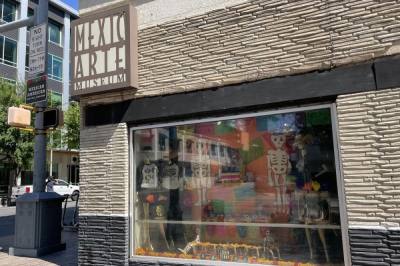The big picture
This fall, the museum is celebrating the 40th anniversary of its “Austin-style” Day of the Dead celebration: Viva La Vida. The festival is the largest and longest-running Dia de los Muertos celebration in the city, according to its website.
“We’ve been doing this for 40 years, and it is an amazing accomplishment,” said Kaitlyn Zaldana, Mexic-Arte’s special events and marketing coordinator. “We brought the exhibition back this year, mostly to focus on artists who have a really intimate connection to the museum and who have contributed to our celebrating 40 years of Dia de los Muertos.”
Zaldana said although the museum usually commemorates the holiday with a festival and annual parade, Mexic-Arte is reflecting on its unique history this year with the addition of an exhibition presenting artworks from its collection and archives.
Mexic-Arte’s “40 Years of Dia de los Muertos” exhibition also presents different cultural traditions and customs by displaying authentically created ofrendas, or offering altars; photographs; handcrafted calaveras, or sugar skulls; and a community ofrenda. The museum’s most admired installation is by Connie Arismendi and titled “Soy el Poema de la Tierra,” or “I am the Poem of the Earth.”
“[Arismendi’s] is a really cool representation of a physical manifestation of an altar because she uses a resurrection plant, which is a plant that can come back to life. They've got a projection going that kind of shows the whole life cycle, which ties into the idea of connecting life and death through Dia de los Muertos,” Zaldana said.
Diving in deeper
Dia de los Muertos originated from the pre-Hispanic rituals of the Indigenous peoples in Mexico, who practiced celebrating life rather than mourning the death of a loved one, according to a report from UNESCO Intangible Cultural Heritage.
Through this tradition, families guide their loved ones' souls back to earth and participate in festivities from Oct. 31-Nov. 2. Although rituals and customs might differ depending on the region, families honoring their loved ones build altars in their homes and place offerings, such as favorite foods, marigold flowers and photographs, on it to try to persuade their family members to return home.
“It is an observance of the cycle of life and death,” Zaldana said. “It's a really beautiful way to think about that cycle, as opposed to other conceptions of death in that it can be really daunting and scary, but it brings a human element to it and reminds us that everyone is going to face it at some point. It's something that you can feel comfortable with and secure about.”
Dia de los Muertos traditions also include wearing skull masks as well as decorating houses with colorful skulls; skeletons; other death-related symbols; and paper cutouts, called papel picado.
What’s next
The exhibition opened Sept. 22 and will continue until Jan. 7. The exhibition also includes artworks from local artists and others, such as Sam Coronado, Rina Lazo, Tita Griesbach and Mexic-Arte co-founder Pio Pulido.
Despite themes of the exhibition surrounding Hispanic and Latino culture and tradition, everyone is encouraged to attend, Zaldana said.
“If [visitors] aren't already familiar with the celebration, I think that they would walk away with a really unique and clear understanding of history and general themes surrounding Dia de los Muertos,” she said. “They would also have probably a better understanding of the kind of culture and respect that's there. Honestly, [they could] expect to see a combination of things that are really important to Mexico modern day, and things that have been important to our community.”
“40 Years of Dia de los Muertos” explains the important traditions of Hispanic and Latino communities by providing insight into how family is tightly interwoven into the culture, said Richard Greene, an attendee and employee of the museum.
“This exhibition in particular really fosters that sense of community and one’s identity with all these people and within the greater fabric of these loved ones that they choose to be around,” he said. “I think this exhibition is reflective of that.”
One more thing
Mexic-Arte does not have designated parking, but Pay to Park and parking garages are available surrounding the streets near it. The museum requires a ticket purchase to enter: Adults pay $7; seniors, active military, veterans and students pay $4; and children age 12 and younger are charged $1.







